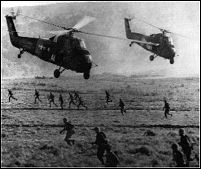Part III – Coming of Age
Both Army Aviation and the helicopter came of age during the conflict in southeast Asia. From the arrival in Vietnam of the first Army helicopter units in December 1961 until the completion of the disengagement and Vietnamization processes in 1973, it was America’s “Helicopter War.”
The most widely used helicopter, the UH-1 Iroquois or Huey, began to arrive in Vietnam in significant numbers in 1964; before the end of the conflict, more than 5,000 of these versatile aircraft were introduced into southeast Asia. They were used for medical evacuation, command and control, and air assault; to transport personnel and material; and as gunships. The AH-1 Cobra arrived in 1967 to partially replace the Huey in its gun ship capacity. Other important helicopters in Vietnam included the CH-47 Chinook, the OH-6 Cayuse, the OH-58 Kiowa, and the CH- 54 Tarhe.
5,000 of these versatile aircraft were introduced into southeast Asia. They were used for medical evacuation, command and control, and air assault; to transport personnel and material; and as gunships. The AH-1 Cobra arrived in 1967 to partially replace the Huey in its gun ship capacity. Other important helicopters in Vietnam included the CH-47 Chinook, the OH-6 Cayuse, the OH-58 Kiowa, and the CH- 54 Tarhe.
Although the concept of airmobility had been developed with a mid-intensity European conflict in mind, Army Aviation and the helicopter had proven themselves during the low intensity conflict in southeast Asia. Afterwards, the Army turned its major attention back to the threat of a mid or high intensity conflict in Europe and doubts reemerged about the value of helicopters in that sort of arena.
Some military leaders believed that the helicopter could not survive and perform an essential role in a heavy combat environment. In order to gain general acceptance and ensure further success, Army Aviation continued to develop new doctrine, tactics, aircraft, equipment and organizational structure. New or radically modified aircraft adopted during the early 1980’s consisted of the AH-64 Apache, the UH-60 Black Hawk, and the OH- 58D version of the Kiowa.
The creation, implementation and consolidation of the Army Aviation Branch dominated the 1980’s. Prominent aviators, as well as other Army leaders had debated the establishment of aviation as a separate branch since the time of the Korean conflict.
The opposition to a separate aviation branch had resulted in part from Army attitudes regarding the Army Air Corps and the U. S. Air Force. In Army circles, both of these aviation organizations were believed to have been unreliable in performing their mission of supporting the ground forces — even after having been given resources to do so. Since Army Aviation had demonstrated its commitment to the support of the ground battle in Vietnam, however, opposition to a separate aviation branch began to wane.
 Also, Army Aviation had grown in size and technological sophistication. This growth caused increasingly complex problems in training, procurement, doctrine development, proponent responsibility and personnel management. Many non-aviators, as well as aviators became convinced that these problems could be solved more effectively by the creation of an aviation branch.
Also, Army Aviation had grown in size and technological sophistication. This growth caused increasingly complex problems in training, procurement, doctrine development, proponent responsibility and personnel management. Many non-aviators, as well as aviators became convinced that these problems could be solved more effectively by the creation of an aviation branch.
Both DA and TRADOC conducted extensive studies of the separate- branch question during the early 1980’s. By 1983, there was a near consensus among Army leaders and the Secretary of the Army signed an order creating the Army Aviation Branch with an effective date of 12 April 1983.
Aviation officer basic and advanced courses were begun at Fort Rucker in 1984 and a gradual consolidation of aviation-related activities followed. In 1986, the U. S. Army ATC Activity became part of the branch; the following year, an NCO academy was established at Fort Rucker. In 1988, the Army Aviation Logistics School, which had been dependent on the Transportation Center at Fort Eustis, was incorporated into the Aviation Branch.
Also in 1988, the Army Aviation Modernization Plan was given final approval and implemented. The modernization plan called for a gradual reduction in the number of Army aircraft as older models were replaced by modern ones. Aircraft adopted or planned during the late 1980’s and early 1990’s included the OH-58D Kiowa Warrior, the RAH-66 Comanche, and a new training helicopter.
Army Aviation’s role of providing the indispensable vertical dimension to the modern battlefield has come to be universally recognized. For example, during operations in Grenada, Panama and the Persian Gulf region, Army Aviation played major and decisive roles.
One of the very first blows of Operation Desert Storm was struck by Army Aviation. Apache helicopters destroyed Iraqi early warning sites shortly before allied bombs began exploding over Baghdad. Then, during the 100 hours of ground combat, Army helicopters dominated night-time operations.
The decreased military budgets following the end of the Cold War forced both the Army and Army Aviation to downsize. Army Aviation’s response was to develop the “Aviation Restructure Initiative,” a plan to decrease the size of the force while continuing to meet its mission and also overcoming existing deficiencies. The ARI aims to accomplish these goals through continued modernization of the fleet and reorganization of the force.
The post-Cold War environment provides new opportunities for Army Aviation to serve our country. Aviation is uniquely qualified for infiltration, reconnaissance, evacuation and strike missions of unconventional warfare. Because of its unique combination of versatility, deploy-ability and lethality, Army Aviation is assuming additional missions and functions in the rapidly changing world of the new millennium.
